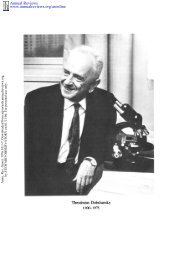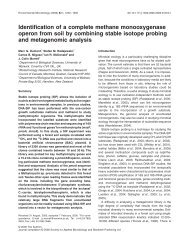Conservation of the vaquita Phocoena sinus - The Department of ...
Conservation of the vaquita Phocoena sinus - The Department of ...
Conservation of the vaquita Phocoena sinus - The Department of ...
You also want an ePaper? Increase the reach of your titles
YUMPU automatically turns print PDFs into web optimized ePapers that Google loves.
202 L. Rojas-Bracho, R. R. Reeves and A. Jaramillo-Legorreta<br />
• A comprehensive regional environmental education programme could provide training for<br />
fishermen and teachers, and would represent a long-term investment for <strong>the</strong> region.<br />
• Each community’s ability to respond to <strong>the</strong> various options is distinct, and local outreach<br />
persons are needed to maintain and coordinate involvement at <strong>the</strong> individual and community<br />
level.<br />
• At El Golfo, in which no viable alternatives to fishing currently exist, careful study is needed<br />
to identify fishing zones and seasons where/when sustainable fishing might be conducted to<br />
benefit <strong>the</strong> local economy.<br />
• At San Felipe, <strong>the</strong>re is strong interest in participating in <strong>vaquita</strong> research. <strong>The</strong>refore,<br />
observers should be placed on-board all boats, and fishermen should be trained to release<br />
<strong>vaquita</strong>s that are found in nets alive (an exceedingly rare event).<br />
• San Felipe could probably benefit from education programmes and assistance in promoting<br />
<strong>vaquita</strong> conservation through tours or exhibits.<br />
Bracamonte (2001) used social-accountability-matrix and multisector models to analyse <strong>the</strong><br />
existing socio-economic structure and <strong>the</strong> implications <strong>of</strong> a change in economic policy at San<br />
Felipe, which is among <strong>the</strong> most important communities <strong>of</strong> <strong>the</strong> region in terms <strong>of</strong> size and<br />
economic influence. His goal was to improve understanding <strong>of</strong> <strong>the</strong> prevailing economic<br />
conditions in San Felipe and to predict <strong>the</strong> consequences for <strong>the</strong> local economy <strong>of</strong> a transformation<br />
in fishing activities, including <strong>the</strong>ir disappearance. He began by examining previous<br />
studies that had concentrated on specific aspects <strong>of</strong> <strong>the</strong> local economy. A social accountability<br />
matrix was <strong>the</strong>n used to identify <strong>the</strong> main characteristics <strong>of</strong> <strong>the</strong> community’s productive<br />
structure and to evaluate different economic scenarios and <strong>the</strong>ir effects on <strong>the</strong> local economy.<br />
For example, what would happen if a segment <strong>of</strong> <strong>the</strong> fishing sector were eliminated, or if all<br />
gillnetting were banned?<br />
<strong>The</strong> analysis by Bracamonte (2001) showed that interesting opportunities for diversification<br />
exist and <strong>the</strong>refore that <strong>the</strong> San Felipe economy is not without alternatives to fishing.<br />
In <strong>the</strong> event <strong>of</strong> a severe cutback in fishing, <strong>the</strong> local economy would not be devastated.<br />
This means that in San Felipe at least, it should be possible to impose fishing regulations<br />
and introduce new fishing gear or methods in a staged or stepwise manner without causing<br />
major socio-economic dislocation.<br />
Biosphere Reserve<br />
Establishment <strong>of</strong> <strong>the</strong> Upper Gulf <strong>of</strong> California and Colorado River Delta Biosphere Reserve<br />
(hereafter termed ‘<strong>the</strong> Reserve’) in June 1993 was heralded as a major step towards protecting<br />
both <strong>the</strong> <strong>vaquita</strong> and <strong>the</strong> totoaba (IWC, 1997). <strong>The</strong> presidential decree was read in a ceremony<br />
attended by governors <strong>of</strong> <strong>the</strong> Mexican states <strong>of</strong> Baja California and Sonora and <strong>the</strong> US state<br />
<strong>of</strong> Arizona and by <strong>the</strong> US Secretary <strong>of</strong> <strong>the</strong> Interior. In his decree, President Salinas stated<br />
<strong>the</strong> intention <strong>of</strong> <strong>the</strong> government <strong>of</strong> Mexico to establish a central ‘nuclear’ zone in which all<br />
exploitative activities would be prohibited. Fur<strong>the</strong>r, he envisioned a prohibition on shrimp<br />
trawling in both <strong>the</strong> core and buffer zones, i.e. north <strong>of</strong> a line traversing <strong>the</strong> nor<strong>the</strong>rn Gulf<br />
from Puerto Peñasco to San Felipe. All gill nets with mesh sizes greater than 4 inches were<br />
also to be excluded from <strong>the</strong> Reserve’s buffer zone. To <strong>of</strong>fset <strong>the</strong> social and economic impacts<br />
<strong>of</strong> <strong>the</strong>se measures, Salinas promised to support economic alternatives in <strong>the</strong> region, such as<br />
tourism, sport fishing and aquaculture.<br />
<strong>The</strong> management programme for <strong>the</strong> Reserve was approved in 1995, calling for <strong>the</strong> preservation,<br />
sustainable use and conservation <strong>of</strong> biodiversity (SEMARNAP, 1995). Among <strong>the</strong><br />
endangered species cited as intended beneficiaries <strong>of</strong> <strong>the</strong> reserve were <strong>the</strong> <strong>vaquita</strong>, totoaba,<br />
© 2006 <strong>The</strong> Authors. Issue compilation © 2006 Mammal Society, Mammal Review, 36, 179–216




